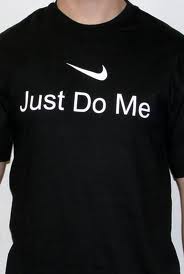Taglines can be extraordinarily powerful. The best are so powerful that they enter the language, and even get spoofed.
So it’s not surprising that advertisers and agencies invest spend a lot of time prospecting for the next Think Different or Where’s the Beef?
And like any prospecting, a lot of dry holes can get drilled before you hit a gusher.
Or things can just click.
Just do it.
Is probably on most people’s top ten list, it’s certainly on Ad Age’s.
With good reason, the line was one of the marketing forces of the 80’s and 90’s driving Nike’s global sales from $ 877 million in 1988 to $9.2 billion in 1998.
So what if it was the result of happenstance rather than hard work.
The documentary Art & Copy (essential viewing for anyone with even the slightest interest in advertising history) cites Dan Wieden referencing convicted murderer Gary Gilmore’s last words “Let’s do it” as the inspiration.
Morbid serendipity or not, Just do it was still an inspired piece of account planning.
Because it addresses a simple truth anyone who exercises regularly will acknowledge; there are days when you feel like just not doing it.
But what makes the line such inspired sales psychology is that 80% of athletic shoes aren’t used for sports at all.
Nike isn’t really in the athletic shoe business it’s in the sneaker business.
Just do it is an amazing piece of positioning because when Joe Sixpack drinks beer in front of the TV he is also basking in the reflected glow of athleticism.
He’s not a bombed couch potato, but an athlete on his day off.
The brilliance of this is undeniable, but so is the fact that any sneaker company could have used it.
Reebok, Adidas, Puma, anyone.
Because in spite of the brilliance, the resonance and the sales, Just do it is utterly generic.
True Wieden and Kennedy executed the campaign flawlessly.
And Nike lived by Just do it, famously signing an amateur Tiger Woods to a $40 million deal in 1996 before he had played a round of professional golf.
But no client ever says to their agency we need a good generic tagline, more likely the reverse we want a tagline that’s so integral to our brand that only we can say it.
Of course that can work too.
We try harder.
Is Number 5 on the Ad Age list.
Back in 1963 when DDB came up with this it was revolutionary.
Perhaps equally impressive is that it’s still in use today.
Except DDB didn’t actually come up with the line, Bob Townsend the president of Avis did as this 1964 article from Time attests.
Again, it may have been happenstance, but DDB had the savvy to recognise, craft and run with it.
And they needed every ounce of that savvy; Avis had lost money for the preceding 13 years.
And it was risky because back then nobody questioned that bigger was better.
Being number one was everything.
Being number two could be seen as weakness.
But being number two and trying harder, to grow, and perhaps one day become number one.
That was seen as a plucky underdog fighting for the American Dream.
And it worked.
The next year Avis made a profit of $1.2 million on revenue of $38 million and market share increased from 11 percent in 1962 to 35 percent by 1966.
The idea of trying harder because you’re number two is clearly not generic, for a start you have to be number 2, being number 3 wouldn’t work nearly as well.
And Avis really did try harder.
And when they screwed up they berated themselves for it – publicly.
Can you think of a brand that would run this mea culpa today?
I can’t.
I like that happenstance, serendipity, coincidence and luck play a bigger role in the industry than we like to admit.
I like that an accident can beat a New Coke.
And I love that advertising is a potent mixture of science and voodoo.
And that the best, is more voodoo than science.






